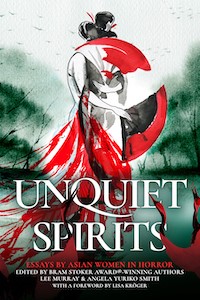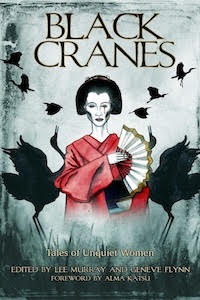Halloween Haunts: Do Ghosts Respect International Borders? by Geneve Flynn
To an Asian Australian, Halloween is a delightful, albeit slightly bewildering, phenomenon. It isn’t widely celebrated in Malaysia (where I spent my early childhood) and is really only just starting to take hold in Australia.
I love seeing my American friends share their excitement that fall has arrived and the spooky season is on its way. However, Halloween seems more celebration than haunting, and the ghosts in the States feel somewhat unreal or distant, like they belong to someone else. Someplace else.
Somewhere along the way, I’d come to believe that supernatural beings were endemic to specific locations, and you only got haunted by things that were particular to where you lived. I probably created this magical thinking as an anxious kid with a wildly overactive imagination, trying to get through my childhood days in a culture overflowing with hungry ghosts and vampiric babies. At least I only had to worry about local ghosts, not all possible ghosts, right?
So when I booked my room at the Stanley Hotel for the 2022 pre-StokerCon event— An Evening of Spirited Giving—I was illogically, willfully confident that my stay at one of the most haunted hotels in America would pass without incident.
As my first-ever, in-person StokerCon, the build-up to the pre-event was tremendous. I researched the location extensively, well aware that the hotel had inspired Stephen King’s The Shining. I read about the hotspots of paranormal activity in the main building, and the resident ghosts and their peculiarities. My friend, Lauren Elise Daniels (a ghost-hunt aficionado and Rhode Islander who now lives in Australia), gleefully shared a video of a paranormal investigation at the Stanley, and recommended the best ghost-detection apps to download. It all seemed a bit of a lark, and I honestly didn’t believe I would see anything spectral.
However, I also didn’t not believe. You don’t get through an anxious childhood without hedging all possible bets. You know how you go up to a haunted house and knock on the door, or spend a night in a cemetery, hoping to prove to yourself that ghosts don’t exist? That’s what I did after I checked into my room at the Stanley.
I went to “The Vortex”—the grand staircase in the main building that’s supposed to be a spiral of supernatural energy—to recreate the photo of the shadowy figure from the clip Lauren had showed me. I took a couple more snaps of the hallway, just in case. I checked the photos on my phone: nothing. I walked through the maze inspired by Stanley Kubrick’s version of The Shining with Sarah Read, Brigett Nelson, Lynne Hansen, and Jeff Strand. We did a tour of the grounds, even searching out the pet cemetery. I attended the author signing event and author readings. I had a lovely dinner with Rena Mason and Sarah Read. All seemed well.
Then I retired to the Lodge, where I was staying. None of the websites I’d researched mentioned anything suspicious about the century-old building next door to the main hotel.
Room 1108, my room, was at the end of the quiet hall. It was about 11pm and there was no one else around as I walked toward my door, the thick carpet muffling all sound. I got a frosty little trickle down my back, but I reassured myself I was safe. I’d gone through the dares, I wasn’t staying in the haunted part of the hotel, and I was an Asian Aussie, dammit. These weren’t my ghosts. And I was exhausted after a twenty-six-hour flight and a full day of socializing. I really needed to get to bed.
I got changed, brushed my teeth, and climbed under the covers. I gazed around my room. It was rich with dark wood, a solid leather chair, heavy, black-out curtains. A gorgeous suite, normal in every way; empty of everyone except me. And yet…
Always hedge those bets.
“If there’s anyone else in here,” I spoke to the room, feeling slightly ridiculous but also a little braver, more in control, “please let me have a few hours’ sleep before you start anything. I’m very tired.” I paused. “Thank you.”
Then I fiddled with the light switch, one of those tiny, difficult knobs that are located at the back of the lamp, and plunged myself into darkness.
I lay on my side with the blankets pulled up around my neck, listening, waiting, shivering. I couldn’t get warm, no matter how much I burrowed under the covers. Other guests had complained that their rooms were stifling because the hotel’s protected historical status meant no air conditioning could be installed, but my room was freezing. I thought perhaps the Lodge was just poorly insulated. Exhaustion finally caught up with me and I drifted off to sleep.
A couple of hours later, I woke, sweating all over, except for my back, which was icy cold. I thought I’d flung off the blankets in the night, leaving half of me to chill. With my eyes still closed, I reached around. My heart kicked in my chest; I was completely covered. Then the corner of the bed shifted, as if someone had just stood up. My eyes snapped open and I saw what looked like a large, imposing man standing before the window beside the bed, leaning over me. I could make out the gray curtains through him. My heart climbed into my throat as I fumbled for that atrociously fiddly lamp switch.
Who makes toggles this small and awkward, for goodness sake!
When the light finally clicked on, I lay splayed and frozen, feverishly scanning the room for my shadowy visitor. I was alone.
After a couple of long, long minutes, I got up and checked the room over. Nothing. I looked at my phone in case it was close enough to dawn that I could just stay awake. It was 3.18 a.m. I contemplated leaving the light on so I could try to sleep with one eye open, but the thought of surviving the next few hectic convention days on so little sleep scrapped that idea. I settled for leaving the bathroom light on instead. I crawled into bed and cautiously lay back down.
The next morning, I woke refreshed and untroubled. I showered, got dressed, and rushed down to breakfast with Sarah and Rena, brimming with excitement to tell them about my haunting: a real-life haunting at the Stanley! In the light of day, the heart-pounding visitation had transformed into a marvelous story to share.
However, the ghost wasn’t finished with me. Despite staying at the Curtis Hotel for the convention, eighty-five kilometers away from the Stanley, I would wake, every night for the next five nights, between 3 and 3.30am. I found out later that this is considered the witching hour.
When I returned home to Australia, I googled the Stanley Hotel, heading down more rabbit holes to try to find out about my mysterious visitor, and stumbled upon a site where guests described the exact same sensations I’d had: the chill of a body against their back, the bump of someone sitting down or standing up from the corner of the bed, a large male figure standing over them. A couple of sites mentioned the spirit of “Rocky Mountain” Jim Nugent, a cowboy who lost an eye to a grizzly and who had a penchant for appearing at the corner of a bed. Still others note that Lord Dunraven, a Coloradoan landowner and alleged brothel owner, liked to lurk in closets, breathing down the necks of unsuspecting females in room 401.
Thankfully, I haven’t had any more visitations now I’m back in the land Downunder. I’ll take huntsman spiders the size of dinner plates (you can hear their feet tippy-tapping when they run at you), deadly eastern brown snakes (one got into my son’s kindergarten and chased all the kids into the back office), and magpies over spectral one-eyed cowboys and handsy lords. Well, maybe not the magpies. Every Australian knows the scariest time of year is from August to October—magpie breeding season, when furious birds with razor beaks swoop and every cyclist fears for their lives—not the 31st of October.
Still, after my haunting experience, I have a better appreciation for Halloween; at the very least, American ghosts certainly feel more real. I’m glad I got to stay at the Stanley Hotel and came away with a splendid ghost story. I’m also rather thankful that ghosts seem to respect international borders.
Geneve Flynn is a two-time Bram Stoker Award®- and Shirley Jackson Award-winning fiction editor, author, and poet. Her works have been nominated and shortlisted for the British Fantasy, Ditmar, Aurealis, Australian Shadows, Elgin, and Rhysling Awards, and the Pushcart Prize.
have been nominated and shortlisted for the British Fantasy, Ditmar, Aurealis, Australian Shadows, Elgin, and Rhysling Awards, and the Pushcart Prize.
Co-editor (with Lee Murray) of Black Cranes: Tales of Unquiet Women and poetry contributor to Tortured Willows: Bent, Bowed, Unbroken.
Read more at www.geneveflynn.com.au.
Preview of forthcoming non-fiction:
Excerpt: “Some Things are Dangerous, But Can be Lived With: The Ghost Baby of Malaysian Mythology”
Publication: Unquiet Spirits: Essays by Asian Women in Horror
Editors: Lee Murray and Angela Yuriko Smith
Publisher: Black Spot Books
Publication date: 14th February, 2023
Pre-order link: https://www.amazon.com/Unquiet-Spirits-Essays-Asian-Horror/dp/1645481298
Review blurbs:
“Unquiet Spirits is a collection of intimate, insightful essays that will become essential reading for those looking to understand the voice of women of the Asian diaspora in horror. I can’t overstate how important this book is.”—Priya Sharma, British Fantasy Award-winning author of Ormeshadow
“As an expert in the paranormal I’ve researched ghosts around the globe, but there’s a vast gulf between studying hungry ghosts and fox spirits in scholarly journals, and reading first-hand experience of these extraordinary stories. The pieces in Unquiet Spirits are beautiful, enlightening, poignant, and yes, haunting. This is a must-have book for anyone who is interested in the folklore of Asia and how it has impacted the lives of the women actually living it.”—Lisa Morton, Bram Stoker Award®-winning author of Ghosts: A Haunted History

Some Things are Dangerous, But Can be Lived With:
The Ghost Baby of Malaysian Mythology
By Geneve Flynn
I’ve never met my Aunt Rosemary; she died when my mother was only four or five years old, but her spirit has laid its delicate, restless touch on my life. Her story, her kwee kia’s voice, will continue to echo through the generations that follow.
According to Southeast Asian lore, a kwee kia is a creature made from the spirit of a deceased human fetus, often aborted or stillborn. The ghost baby has many names and transcends several cultures. It is called a toyol in Malay, tuyul in Indonesian, koman-tong in Thai, and a kwee kia (ghost child) in Hokkien.
Brought to life by a bomoh (Malaysian shaman) through black magic, a kwee kia is usually the size of a toddler, with a large head, red or black clouded eyes, pointed ears, fanged teeth, long nails, and green or gray skin. The creature is kept in a jar and must be fed with blood, either through breastfeeding or from the fingers or toes of its keeper. Despite its ghastly origin and description, the kwee kia is relatively harmless, and is only used by its owner to steal or cause mischief.
However, under the direction of a malevolent or neglectful master, a kwee kia can become monstrous, and any riches gained will be at great personal cost. The ghost child is often passed from generation to generation, and may grow stronger over time. Once created, it can be difficult to destroy.
Several Asian transnational female authors have reimagined traditional myths to tell stories of otherness and liminality from their perspectives of diaspora.
Yangsze Choo, a Chinese Malay author, adapted the concept of the hungry ghost to explore themes of filial duty, gender, and sovereignty. In The Ghost Bride, Choo repurposes the mythology to allow her protagonist to unpack traditional cultural norms and to reclaim the power to steer her own life.
Cassandra Khaw, another transnational Chinese Malaysian, reinvents the legend of the hungry ghost in her short story “Some Breakable Things” to depict the pain of loss, difficult relationships, and things left unsaid.
The hauntings in both works hold up for consideration the tension between the cultures of the authors’ countries of origin and the countries they now call home. They dissect the differences in gender expectations, societal norms, and what is real and unreal, and the echoes of the past.
In my short story “Little Worm,” which is the final entry in the award-winning anthology Black Cranes: Tales of Unquiet Women, I adapted the myth of the kwee kia to represent the suppressed hopes and ambitions of the protagonist’s—Theresa’s—mother. I amplified the hereditary and vampiric nature of the ghost child to personify the trauma and lessons we learn from generations past. The kwee kia became the embodiment of an unquiet phantom: something that is passed down from generation to generation, beginning with trauma, morphing and shaped by each age, and which can never be discarded.
When Lee and Angela invited me to contribute to this collection, my first thought was to expand on this exploration, and to delve further into my own family history. My mother has told tales of her childhood, her experiences as a daughter, wife and mother, and of the death of her older sister. However, these retellings seemed to be fragments of a whole, and I wanted to trace the entire narrative, to follow the tendrils that lead back to the formation of my family’s kwee kia, and examine how this urban ghost story could be adapted to interrogate generational trauma.

I’d like to offer a copy of Black Cranes: Tales of Unquiet Women for the giveaway. To be entered in the drawing, please comment below or send an email to membership@horror.org.
Black Cranes: Tales of Unquiet Women
Co-edited by Lee Murray and Geneve Flynn
Winner of the 2020 Bram Stoker and Shirley Jackson Awards
Almond-eyed celestial, the filial daughter, the perfect wife. Quiet, submissive, demure. In Black Cranes, Southeast Asian writers of horror both embrace and reject traditional roles in a unique collection of stories which dissect their experiences of “otherness,” be it in the colour of their skin, the angle of their cheekbones, the things they dare to write, or the places they have made for themselves in the world.
Black Cranes is a dark and intimate exploration of what it is to be a perpetual outsider.




Spirited giving sounded like fun!
SO jealous!